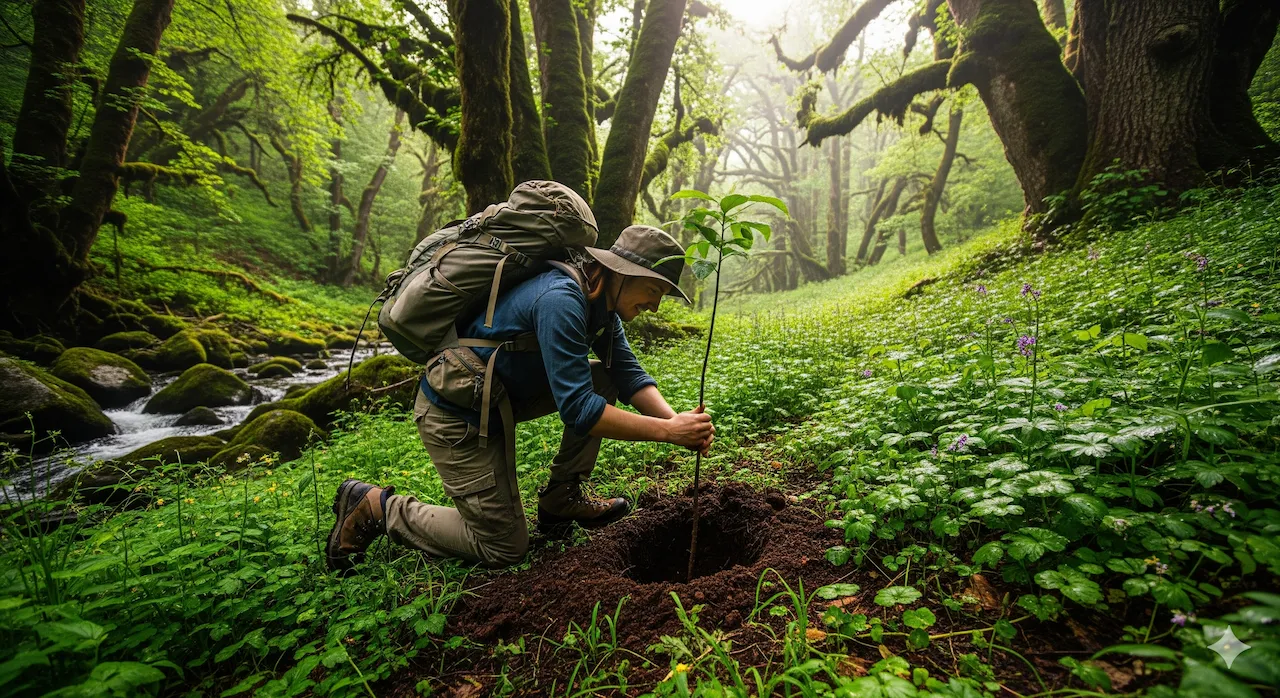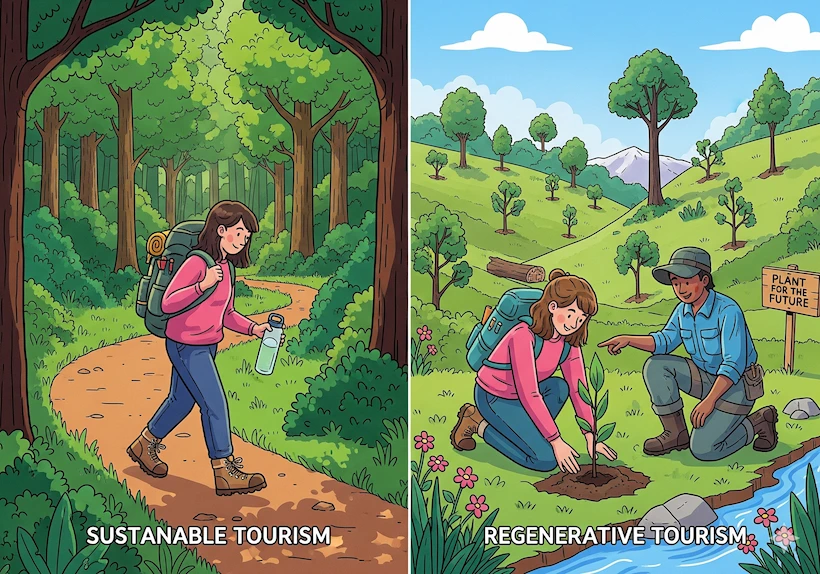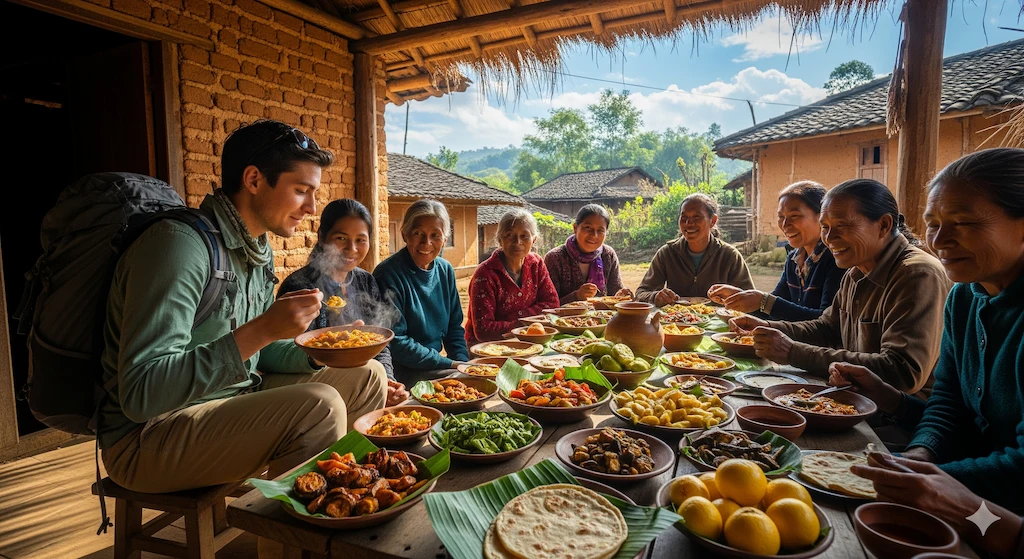GloNews10

Travel is no longer just about seeing new places; it’s about experiencing them in a way that leaves a positive impact. In a world increasingly aware of climate change and social inequality, the traditional model of tourism is no longer enough. The year 2025 marks a turning point, as travelers shift from merely “not doing harm” to actively “doing good.”
That’s where Sustainable and Regenerative Tourism 2025 comes in. This movement explores the core principles of sustainable and regenerative travel, providing a comprehensive guide for anyone looking to make their adventures more meaningful.
We’ll dive into five key strategies, provide real-world examples, and discuss how you can reduce your carbon footprint without sacrificing the joy of discovery. This isn’t just about eco-friendly hotels; it’s about a complete mindset shift that redefines what it means to be a modern traveler.

While the terms are often used interchangeably, there’s a crucial distinction. Sustainable tourism focuses on minimizing negative impacts. Think of it as leaving no trace—reducing waste, conserving water, and respecting local cultures. The goal is to maintain the status quo and ensure destinations aren’t harmed by visitors.
Regenerative tourism, on the other hand, goes a step further. Its goal isn’t just to leave a place as you found it, but to leave it better than you found it. This can involve actively participating in conservation projects, restoring local ecosystems, or contributing directly to community development. It’s a proactive approach that turns travel into a force for positive change.
The transition from sustainable to regenerative travel is a key trend for 2025 and beyond. It acknowledges that simply reducing harm is insufficient to address the deep-rooted environmental and social challenges facing popular destinations. In short, Sustainable and Regenerative Tourism 2025 represents the evolution of travel ethics in our time.

The first and most significant decision a traveler can make is where they sleep. Your accommodation’s environmental and social practices have a massive impact. Look for places with official green certifications, such as LEED (Leadership in Energy and Environmental Design) or Green Globe. These certifications verify a hotel’s commitment to energy efficiency, water conservation, and waste management.
Comparison: Traditional Hotel vs. Eco-Lodge
By choosing an eco-lodge, you’re not just booking a room; you’re supporting a business model that prioritizes the planet.
Regenerative Tourism in Action: The Case of Habitas Namibia
Habitas Namibia is an excellent example of regenerative tourism in action. This luxurious eco-lodge in the Namibian desert not only minimizes its environmental impact but also actively contributes to the local community.
They employ local staff, purchase supplies from nearby vendors, and provide funding and resources for a local school and community garden. Guests are not just observers; they are part of a system that helps regenerate the local economy and social fabric. This approach goes beyond sustainability—it actively builds up the destination and represents the heart of Sustainable and Regenerative Tourism 2025.
Transportation is a major contributor to a trip’s carbon footprint. Making conscious choices about how you get to and around your destination can significantly reduce your environmental impact.
Case Study: The Green Pass in New Zealand
New Zealand, a leader in regenerative tourism, is promoting ground-based travel with initiatives like the “Green Pass.” This pass offers discounts on bus and train travel, encouraging visitors to explore the country’s stunning landscapes without relying on a rental car.
It’s a proactive step to reduce tourist-related carbon footprint and promote a more immersive travel experience—perfectly aligned with Sustainable and Regenerative Tourism 2025.

Food is a gateway to culture, and your dining choices have a direct impact on the local economy. By eating at locally owned restaurants, buying produce from farmers’ markets, and trying street food from independent vendors, you ensure your money stays within the community.
Beyond the Plate: The Regenerative Impact
Supporting local food systems is a form of regenerative tourism. When you buy from a small-scale farmer, you are helping to preserve traditional farming practices, maintain agricultural diversity, and keep land productive. This helps prevent land degradation and keeps communities economically vibrant.
Real-World Example: Costa Rica’s Farm-to-Table Experience
Costa Rica, a global leader in eco-tourism, has integrated the farm-to-table model into its tourism industry. Many lodges and resorts partner directly with local farms. Guests can often tour these farms, learn about sustainable agriculture, and then enjoy a meal prepared with the very ingredients they just saw.
This creates a powerful connection between the traveler, the food, and the land, making the experience deeply regenerative and a cornerstone of Sustainable and Regenerative Tourism 2025.
The most valuable souvenir you can take away is a deeper understanding of the local culture. This requires a shift from being a passive tourist to an engaged traveler.
Regenerative Tourism in Action: Community-Based Tourism in Iceland
Iceland is encouraging visitors to explore beyond its famous Golden Circle by promoting community-based tourism. In remote villages, travelers can stay with local families, learn traditional skills like knitting or fishing, and participate in community events.
This approach not only spreads the economic benefits of tourism more evenly but also helps preserve and regenerate the cultural identity of these small communities—a vital element in Sustainable and Regenerative Tourism 2025.

For the truly conscious traveler, passive engagement isn’t enough. Regenerative tourism often involves taking part in activities that directly benefit the destination.
Case Study: The Great Barrier Reef’s “Reef Guardians” Program
In Australia, the Great Barrier Reef’s “Reef Guardians” program encourages visitors to participate in conservation efforts. Tourists can join guided tours with marine biologists, learn about the threats to the reef, and help collect data or remove invasive species.
This transforms a simple sightseeing trip into a regenerative experience, where every visitor becomes a protector of this natural wonder. Programs like this are prime examples of how Sustainable and Regenerative Tourism 2025 is shaping global travel.
The global shift towards sustainable and regenerative tourism 2025 is more than just a passing trend; it’s a fundamental change in how we view our role as travelers. By 2025, the most sought-after destinations will be those that have embraced these principles, and the most respected travelers will be those who actively support them.
By making conscious choices—from how you get there to what you eat and where you stay—you can significantly reduce your carbon footprint and contribute to a healthier planet and stronger communities. This new era of travel promises more than just new sights; it promises deeper connections, richer experiences, and a positive legacy for generations to come.
In the end, Sustainable and Regenerative Tourism 2025 isn’t just about destinations—it’s about transformation. It’s about reshaping the way we experience the world and ensuring that travel becomes a force for good.